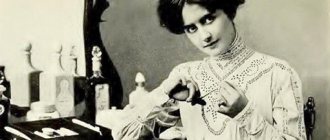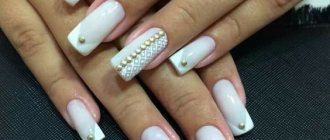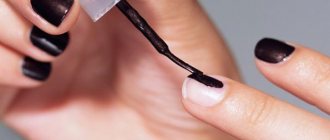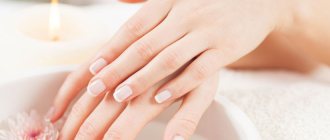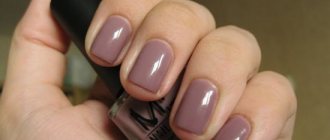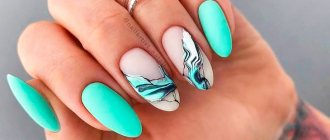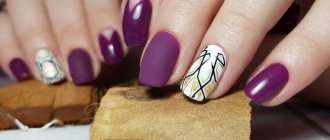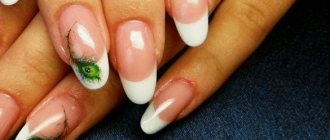Today, manicure and nail care have a special place in the beauty industry. Clean and tidy hands indicate a woman’s well-groomed nature and her desire to look perfect under any circumstances. Among other things, now many men take care of their nail plates by doing a standard hygienic manicure. Few people know where the tradition of monitoring the condition of one’s hands comes from, but it is clear to everyone that its origins are hidden in the deep past.
The fact that the history of manicure has very ancient roots is evidenced by excavations of an Egyptian tomb in which the remains of Hanumhotep and Niankhanum were found. These are the names of two representatives of the retinue of Pharaoh Nuser, who bore the honorary title of “master and guardian of nails” of the great ruler. People who lived in those distant times 2400 BC treated the masters who mastered the art of manicure with special respect.
At that time, nails were decorated not only by women, but also by men of noble blood, since there were no gender differences in manicure. Before an important battle, Roman and Assyrian warriors always painted their nail plates with multi-colored dyes, performing a certain ritual.
The most ancient origins of manicure art
For those who are interested in the history of manicure, it will be very interesting that in Ancient Egypt it was possible to determine by the nails which class a person belonged to. Noble people painted their nail plates in bright and rich colors, but slaves were allowed to use only pale pastel shades. During the Middle Ages, henna was a very popular dye, which Cleopatra herself loved to use. Her long nails were always painted a rich terracotta color.
In Ancient China, special attention was paid to nails. It was believed that a long manicure was a sign of wisdom, so the Chinese carefully grew their nail plates and painted them in different colors. The history of manicure of this period is marked by the fact that the Chinese learned to make varnish from natural ingredients and natural dyes. To do this, they used gelatin, egg yolks, gum arabic and wax, creating vibrant shades by adding natural dyes. Later, varnishes based on silver and gold became popular, and during the reign of the Ming Dynasty, red and black colors were considered more relevant and in demand. In the East in the 17th century, women exhausted themselves with the most complex procedures, during which a dye of plant origin was introduced into the matrix of the nail plate. This allowed them to grow colored nails.
The history of manicure in Ancient Greece is associated with ancient rituals and superstitions. Manicurists of those times never completely painted over the nail plate, leaving a hole of natural color. The ancient Greeks identified this part of the nail with the moon, believing that there was something mystical in this tradition. Some Old Believers still believe that sorcerers and magicians can communicate with spirits through their nails.
For a long time, long and bright nails were considered unacceptable and indicated bad taste. Short natural nails, painted in discreet tones, have become fashionable. Bright shades of manicure were preferred by courtesans, actresses and fallen women. And in the 16th century, owners of colored nails were called witches and could be burned at the stake.
Interesting Facts
"Manus" - hand, "cura" - care. This is exactly how the familiar word “manicure” is translated from Latin. A set of cosmetological actions aimed at improving the condition of the nail plate and hands, as well as improving their aesthetic appearance.
Some interesting facts:
- The first manicure appeared more than 5,000 years ago. Then natural henna or charcoal helped to add color, and natural gold tools were used to process the nail bed and cuticle.
- A little later, 2,000 years later, slaves received permission to have manicures. They were allowed to paint short nails and use only subtle colors;
- During the Inquisition, painted nails were considered a sign of witchcraft. Fashionistas were burned at the stake;
- Only in 1914 was the first officially registered patent for a nail protection product, in other words, varnish.
Initially, manicure was used to maintain healthy nails and hygiene, and after just a couple of hundred years it also became an indicator for determining class.
Modern manicure outlines
The history of manicure entered a new stage of its development in the 1830s in France, when an inflamed hangnail appeared on the finger of King Louis Philippe. In order to cope with this problem, the court doctor had to perform a simple operation. After this, the king instructed the doctor to create a special set for caring for nails and hands. Such kits quickly became popular, and by the beginning of the 20th century, manicure tools began to be produced at an industrial level, which made the kits accessible to everyone. This kit included the essentials: a suede file, an orange stick, hand ointment and powder.
Somewhat later, care products appeared on sale that enhanced the shine of the nail plates. And then came the turn of the first varnishes, which were a paste. This mixture was applied to the nails and the surface was polished until the desired result was obtained. And already in 1932, the first red varnish appeared in Europe, somewhat reminiscent of modern decorative coatings. After some time, the production of varnishes of various colors begins. Since this period, elongated nails, which are given different shapes, have come into fashion. However, not all women could boast of a beautiful and long manicure, so they had to experiment in every possible way to achieve a similar result. For the sake of their own attractiveness, the girls glued rice paper, pieces of fabric, etc. to their natural plates, securing it all with varnish.
Ancient China
Chinese women loved not only to paint their nail plates, but also to surprise with their incredible length. They deliberately did not cut off the overgrown nail in order to show others their importance and demonstrate luxury. To prevent overgrown nails from breaking, the Chinese came up with special protective covers - one for each nail. The tips were made of gold and silver, which made them accessible only to the rich.
Dyeing was a long procedure, especially if a woman wanted a bright crimson color. Natural dye, made from natural components, was applied to the plate from 3 to 14 times. With each new layer the color became more saturated.
By the way, natural plant leaves were used for the procedure, which were filled with dye, wrapped around a finger and secured with thread.
Manicure and nail art these days
A modern woman does not need to invent anything when lengthening her nails, since now it is possible to create a neat and beautiful manicure using gel or acrylic. As for hand care, we can safely say that today we have a huge number of tools and cosmetics to maintain the beauty of a manicure. There are also no problems with the choice of varnishes, since the market offers a wide selection of decorative coatings from various brands. Today we have convenient modern technologies; several types of manicure are available to us, differing in the sequence of processes and the use of various tools.
Summarizing the above, I would like to note that manicure is an art that has its own interesting history, rooted in the distant past. At different times, manicure was treated differently, but one thing remained unchanged: beautiful and well-groomed hands are always held in high esteem . Take care of your manicure and always look perfect!
19th century France
In 1830, trouble happened - the then reigning King Louis acquired a problem in the form of a hangnail. The painful rupture of the skin caused the man a lot of trouble, so Louis ordered to find a doctor who would help get rid of the hangnail. The king’s hands saw dozens of doctors, and only Dr. Zitts was able to cope with the problem. For the procedure, he used a nail file and natural suede and an orange stick. Later, such sets were in the arsenal of every French woman.
History of European manicure
The history of the appearance of manicure in Europe is radically different from the development of this trend in other countries. Since Europeans considered chastity and modesty to be the main moral values, only representatives of the oldest profession could afford to paint their nails. Simple girls kept their nails clean and tidy and nothing more. A big impetus for this attitude was the policy of Queen Victoria, who was known as the Virgin Queen, who preached Puritan decency and purity. Therefore, the only manicure accessories for women left were pieces of suede for polishing nails. Today, special polishing devices are made based on suede material.
The beginning of French manicure, the technology of which is so popular today, dates back to this era. Jeff Pink, president of the famous American company ORLY, is considered the inventor of such a fashionable and sophisticated coating as the French one. In 1976, one of the Hollywood directors asked Pink to come up with a universal nail polish for his actresses, so as not to paint their nails for each stage image and costume. Since everything natural was considered universal, it was decided to cover the nail with a natural peach color and paint the edge white. This blanket coordinated perfectly with all the outfits.
We recommend:
Step-by-step instructions on how to paint shellac correctly
They began to call French manicure at the request of the author himself, because at that time all the best was done in France. This commercial move proved to be incredibly successful and has been the epitome of elegance and beauty for many years.
Return to contents
The final stage of a classic manicure
The trimmed manicure ends with a hand massage with nourishing oil or moisturizer. The nail growth area, which opens after removing the cuticle, perfectly absorbs all substances, and massage helps improve blood circulation in the capillaries, so that the skin and nails receive more intense nutrition. Often, nail artists include individual elements of trimmed manicure in other manicure techniques - if, for example, you need to cut off hangnails or a very overgrown cuticle that cannot be removed by other methods. And for people with rapidly growing cuticles and rough skin, trimmed manicure is simply irreplaceable.
If all the necessary conditions are met, a classic manicure is completely safe, and its effect – both aesthetic and hygienic – exceeds all expectations.
The cost of a classic edged manicure service is 400 rubles.
How did Japanese manicure appear?
Japanese women have always been distinguished by their extraordinary beauty and ingenuity in terms of care. Nails in Japan began to receive attention back in the 8th century, when court ladies began painting them using natural products. Geishas also sought to conform to new fashion trends and followed the rich women, surprising men even more.
Since then, manicure in Japan has undergone many changes, but preference is given to products made from natural ingredients. It was the natural substances in the composition of the products that made it possible to distinguish Japanese manicure as a separate area for the treatment of weakened nails.
Gel modeling
Tired of acrylic “fragrances,” masters were looking for how to get the same hardness of nails in combination with more comfortable work. And around this time, His Majesty modeling gel entered the arena - essentially the same acrylic with a monomer, only in a stable form. For it to harden, special conditions were needed - yes, that’s when the first lamps for ultraviolet curing of materials appeared. Gel technology turned out to be compatible with any types of extensions.
The gel could be moved and adjusted on the mold as much as desired before polymerizing. It was much easier to saw and had virtually no unpleasant odors, so it quickly won an army of fans. The downside was that it got hellishly hot in the lamp, especially when placed at a high altitude. The gel was used to “entrust” the tip technology of extension: now the tip was used only as a substrate, on top of it it was possible to build an architecture with gel and create a wearable shape of any length and complexity. This is what the masters actively used.
Job prospects
Job prospects for a nail technician:
- An experienced master can participate in nail tournaments and exhibitions.
- When an employee understands that he is ready to share his experience, he can try himself as a teacher, become an instructor, or create his own online or offline courses. In this case, you can combine teaching and working with clients.
- You can develop a client base, become a private owner, thereby increasing your income.
- You can open a studio, hire craftsmen, transfer your client base to them - just do business.
Manicure in Ancient Rus'
Our ancestors, when it came to caring for themselves and their appearance, were very developed and thoughtful. The Russian soul was so unique and had its own attitude even to ordinary nails.
Here are just some of the superstitions and sayings that our ancestors used for a long time:
- Cutting nails was allowed only once a week, only on Thursday. If you disobey this, then the person could simply get sick or get into some major trouble.
- After completing the nail cutting procedure, they were under no circumstances thrown away, but only burned in the oven. The ashes that remained from them had to scatter to the wind.
There was a belief that it was possible to cure almost any chronic and non-chronic disease if you correctly burned the nails that had recently been cut from a sick person. They had to either be burned or buried very deeply at the crossroads.
There were other funny and seemingly stupid prohibitions. Take, for example, shepherds - they were strictly forbidden to cut their nails during the grazing season. The shepherds entered into real “contracts” with the natural guardian of the forest - Leshim, and according to this unwritten agreement, they were forbidden to kill the inhabitants of the forest, order their livestock, and, of course, cut their nails.
According to the beliefs of our ancestors, the strength and magical power of the human body lay in the nails. The longer and healthier they were, the stronger the person was, the stronger the person’s connection with the subtle world.
If you think that these naive beliefs and signs are a thing of the past and do not remind you of yourself in any way, then you are deeply mistaken. Some Russian hinterland settlements still support these beliefs. For example, the habit of cutting overgrown nails once a week. And this is done for another reason - to protect yourself and your home from the mines of evil otherworldly forces.
And here are a few more signs and habits that remain with us to this day:
- People who have crooked and sloppy nails are unhappy and have short lives;
- A pregnant girl is forbidden to step on her own cut nail. Otherwise, there will be a threat of fetal miscarriage;
- It is forbidden to cut the nails of newborns until they are one year old. Otherwise, the child faces a poor future;
- If you spit on your nail three times in a row, cut it off, and then divide it into three approximately equal parts, you can easily rid yourself of all kinds of evil eye and slander from evil strangers;
Already in the 19th century, Russians kept up with fashion trends and tried to make their nails more well-groomed and, of course, beautiful. It was during this period that a large stage in the development of manicure began.
